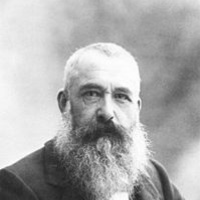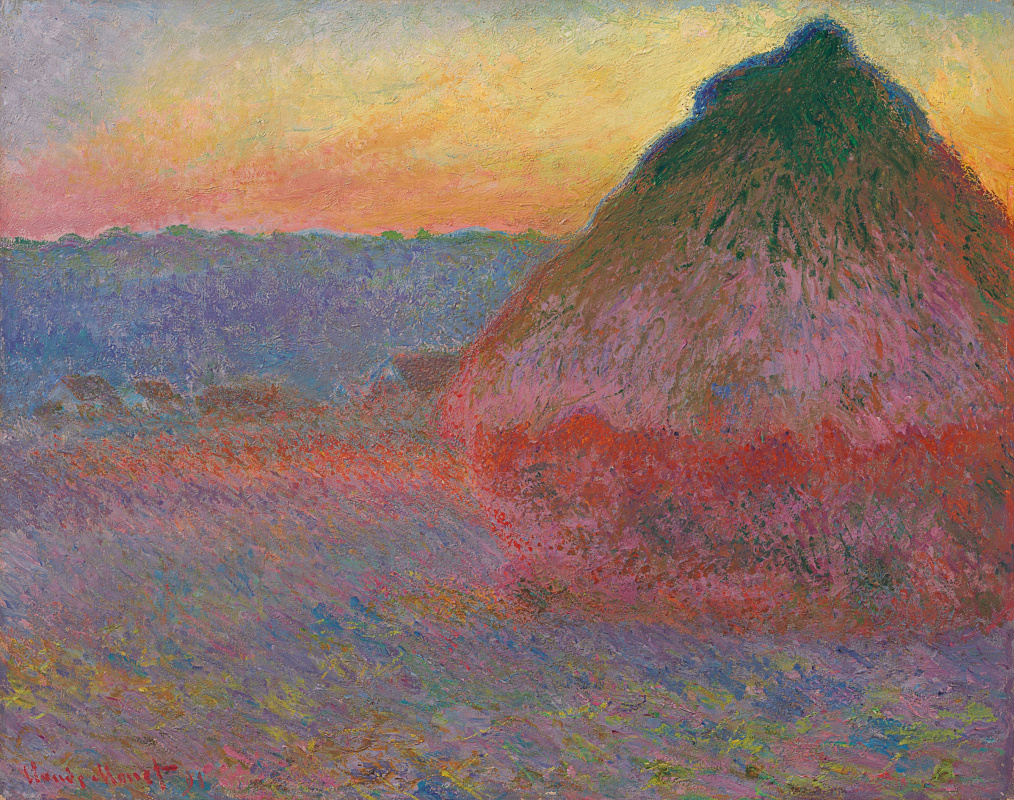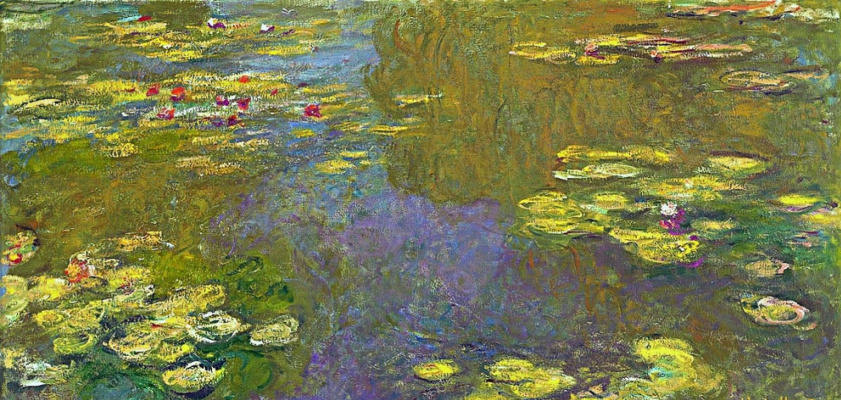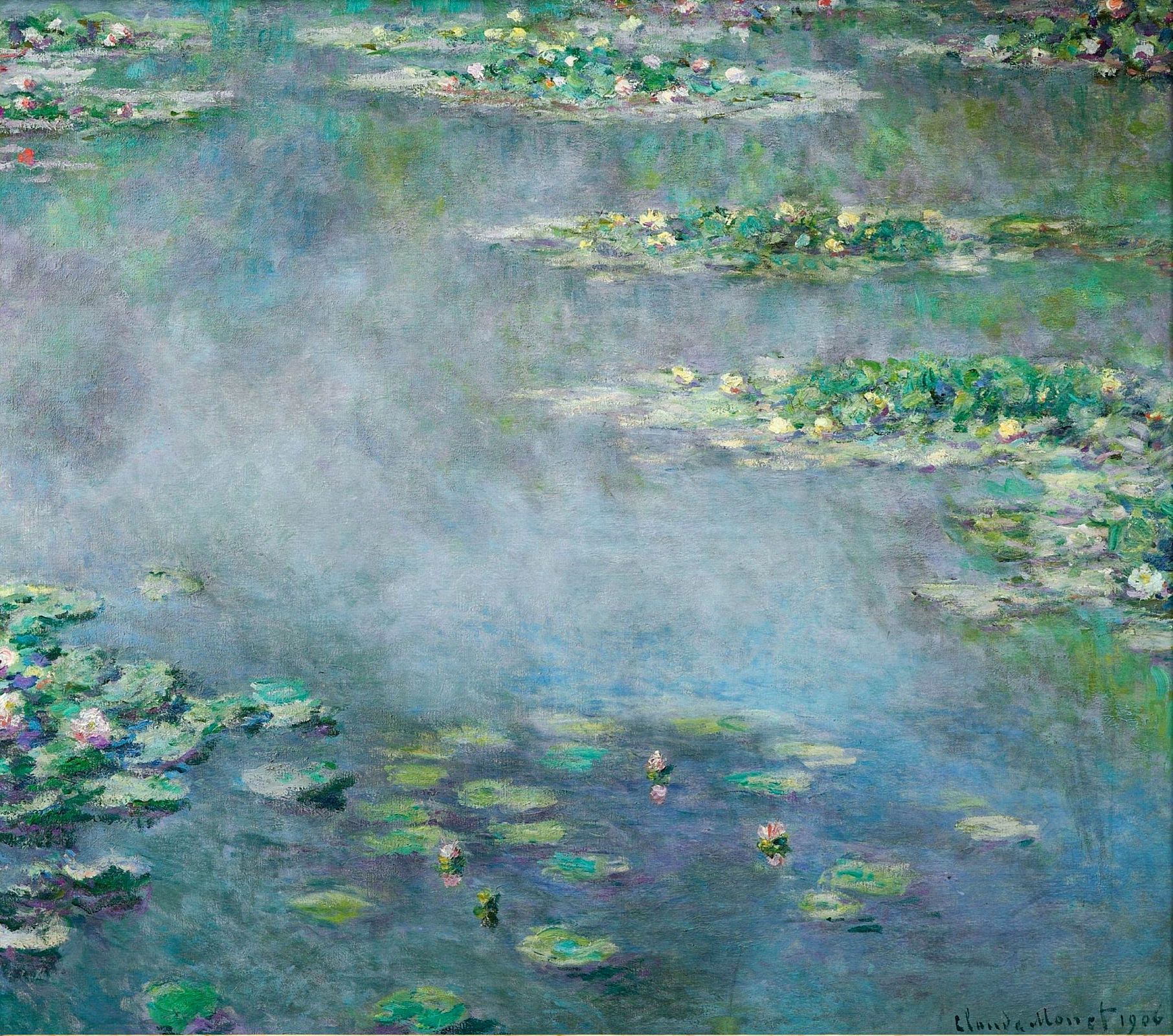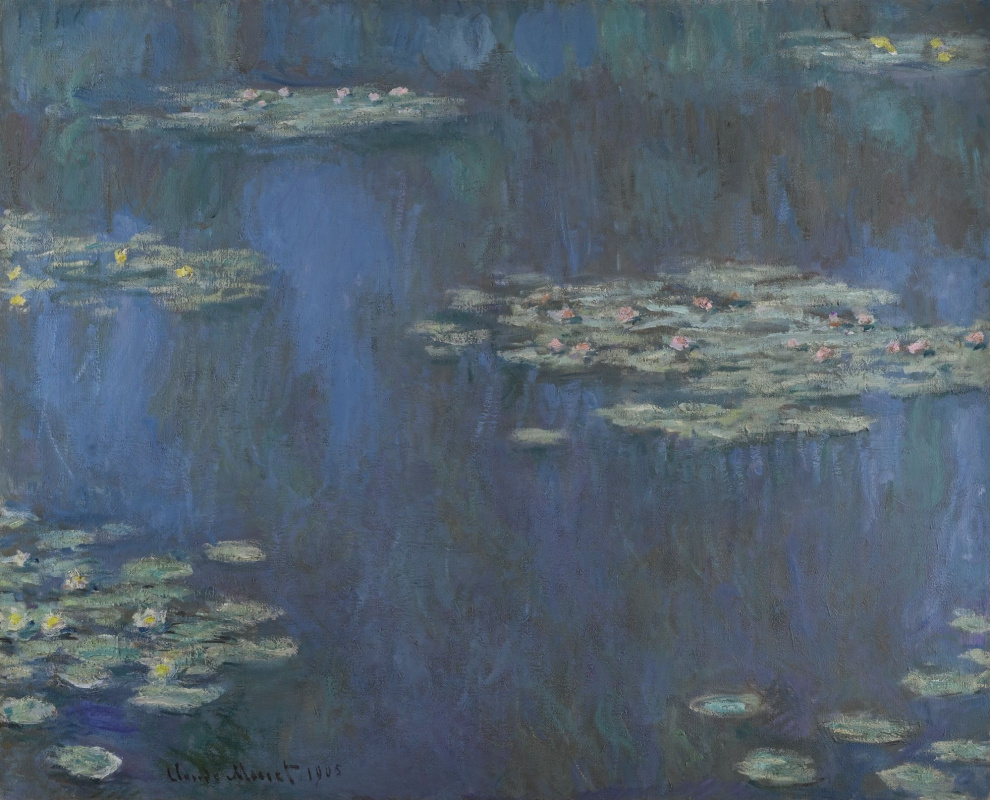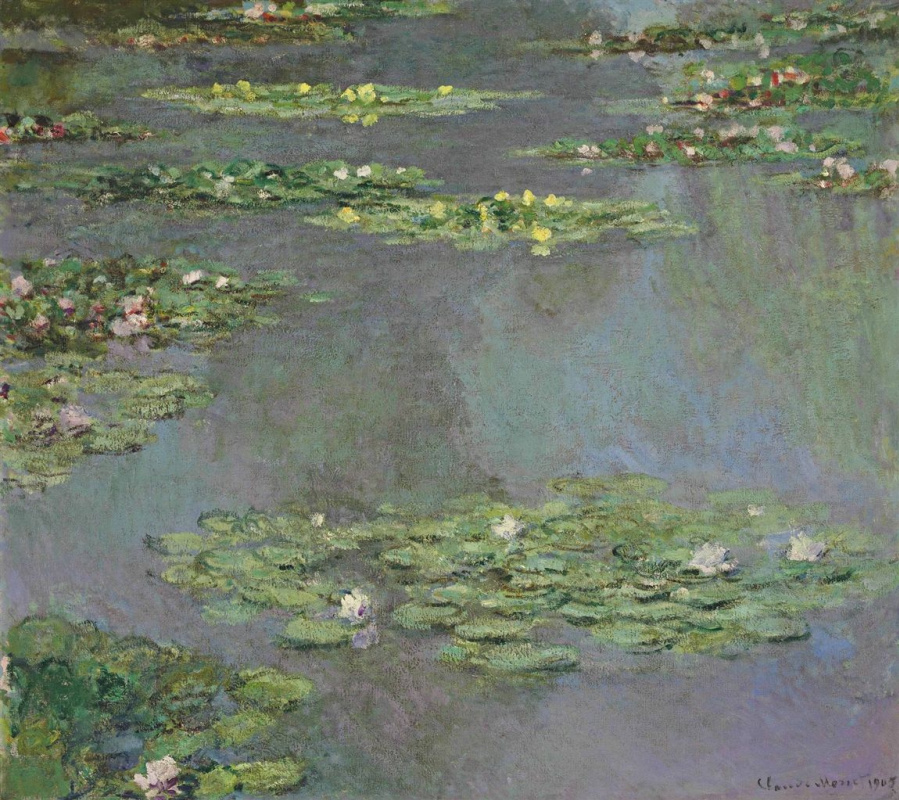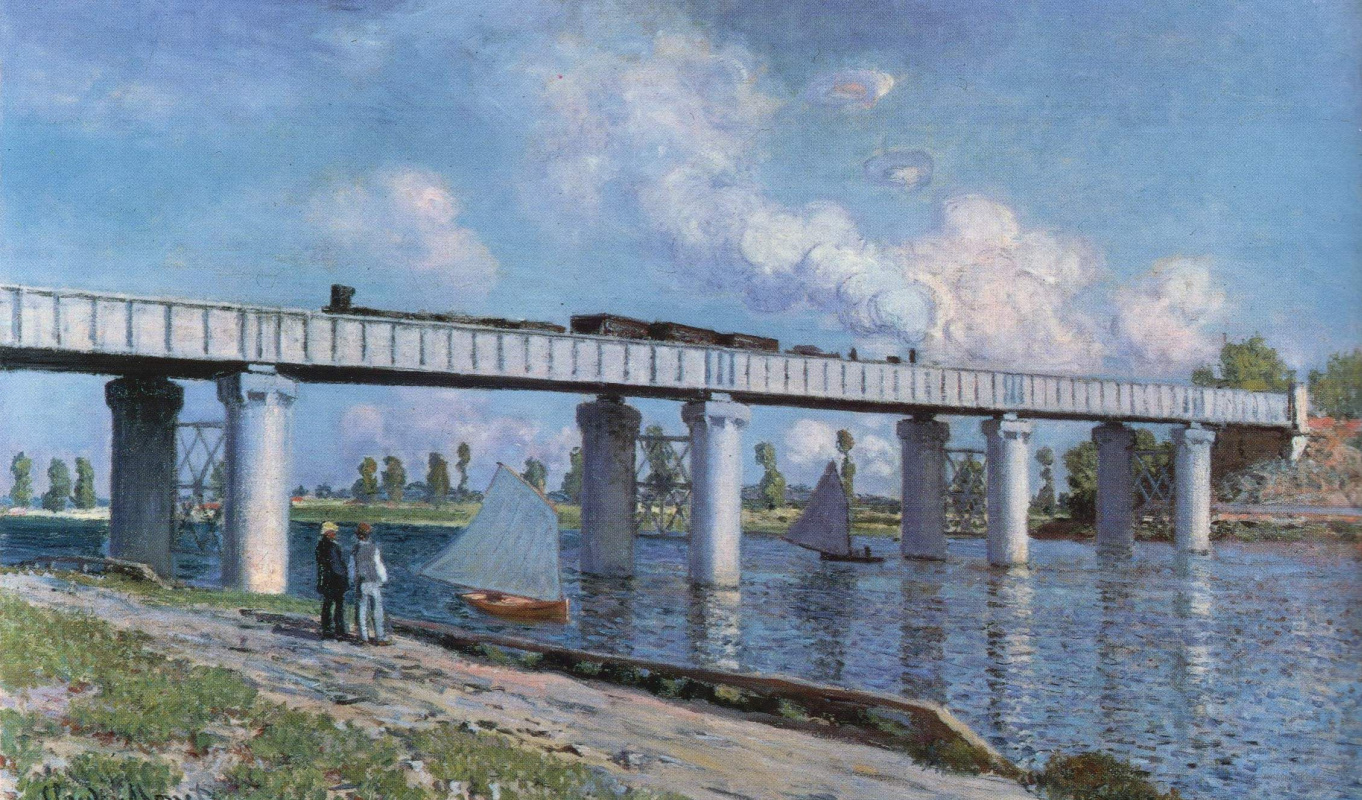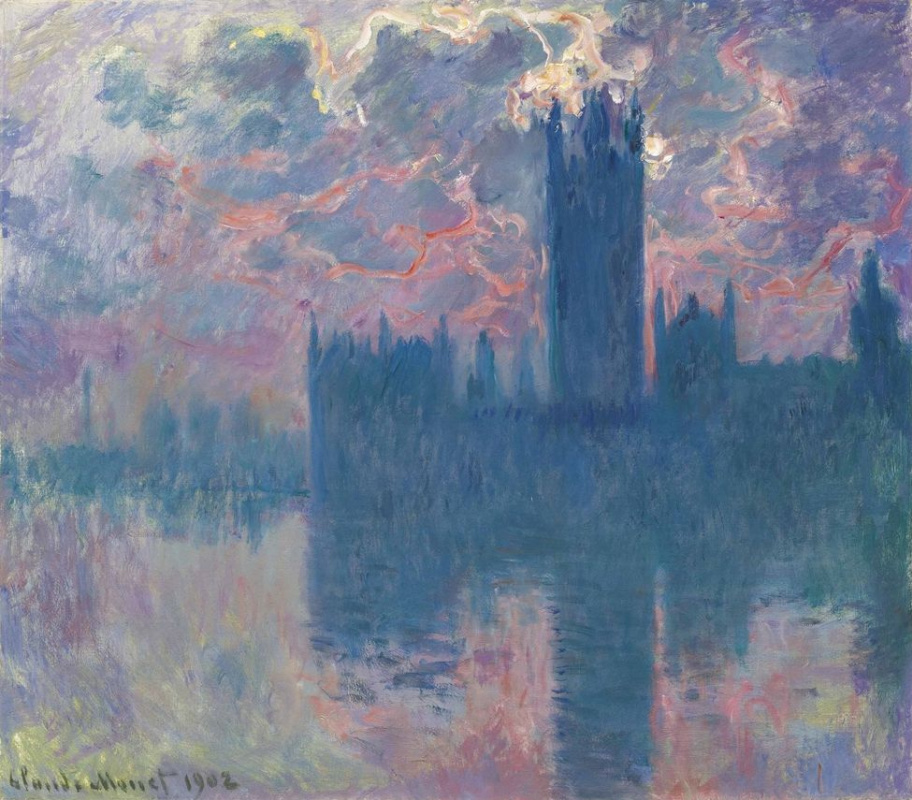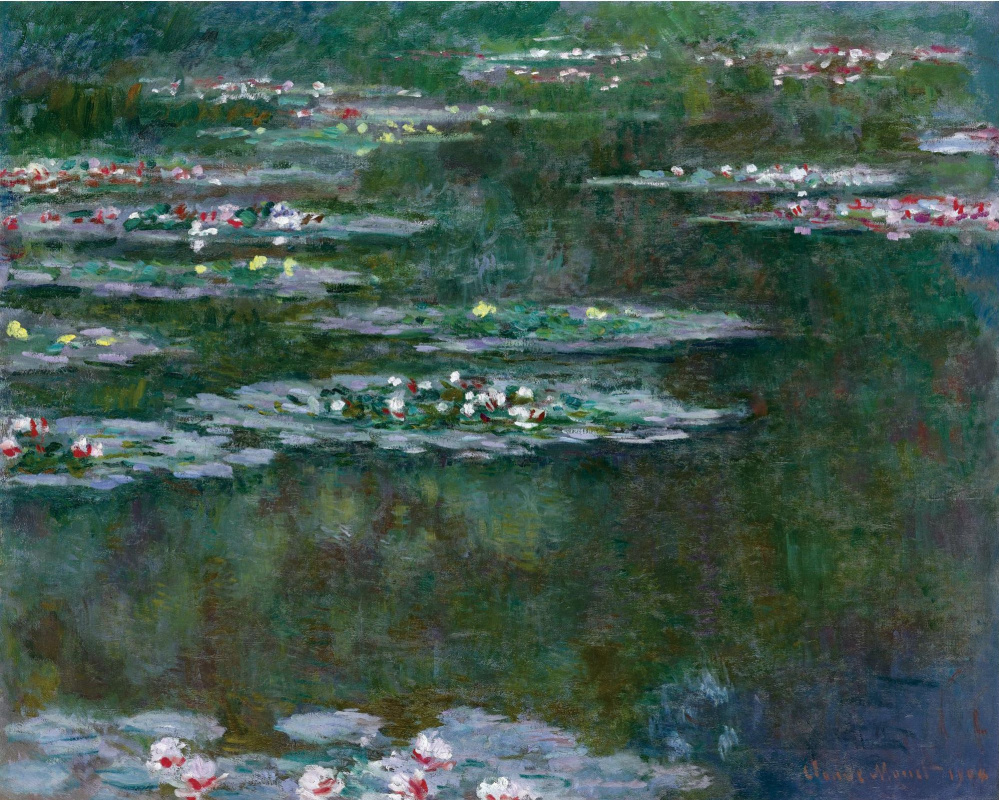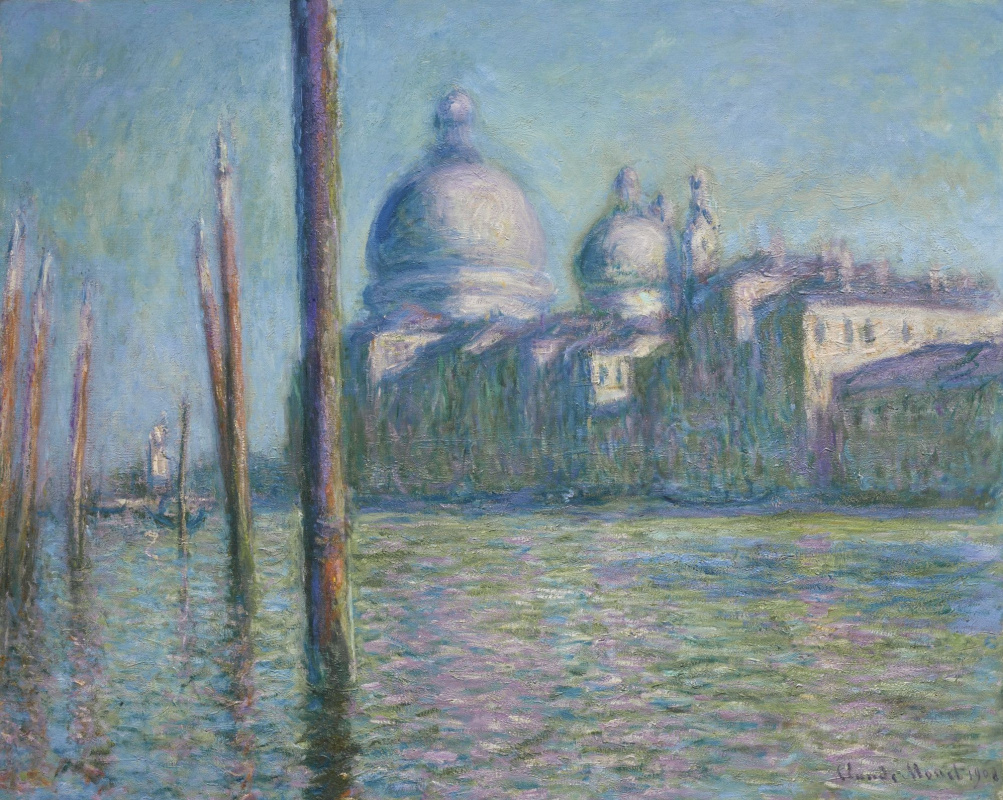When the picture Claude Monetfalls into the auction house of Christie's or Sotheby's, it is immediately declared the top lot of the upcoming auction, and the sale price often exceeds the estimated value. Monet at the auction is always a reason for excitement, excitement, excitement and impressive price tags.
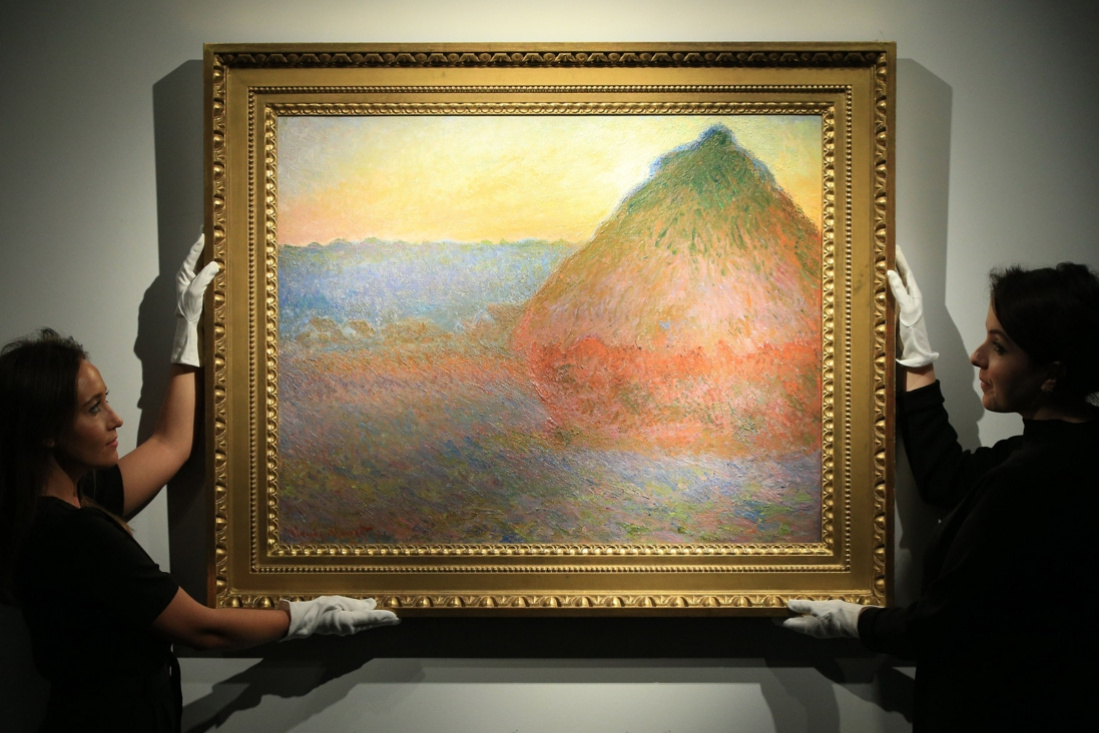
The most expensive, but rather priceless, masterpieces of the empressionist impressionist, of course, are in museums (praise be to heaven, art dealers and philanthropists who have donated their collections to museums around the world over the last hundred years!) It is difficult to imagine a price tag in any of the world's currencies, for example under the picture "Impression. Sunrise"or under the panel with water lilies from the Orangerie Museum (1, 2, 3, 4) But Monet wrote enough water lilies so that some of them adorn someone’s living room.
Meule de foin
1891, 72.7×92.1 cm
1. Claude Monet. Haystack, 1891
Sale: Christie's, 2016.
Price: $ 81,447,500
Provenance: In early 1891, Monet invited to Giverny Fields Duran-Ruelto show a new series of works - haystacksat different times of the year, with different weather and different lighting. It was decided to arrange an exhibition. The success was tremendous: most of the paintings were bought here, in the Duran Ruel Gallery, for the first time Monet received several thousand francs per canvas.
The first owner of this picture was the legendary American gallery Knoedler & Co, the oldest and most famous, it appeared in New York to all American museums and large collections. Founded in America in 1848, in the then provincial art market, Knoedler & Co was first a subsidiary of the French gallery Goupil & Cie. Later, Michael Knoedler, the head of the American branch, bought the branch and became the owner.
When an agent of the American gallery came to Claude Monet to watch “Ricks,” the artist offered five to choose from and accompanied the demonstration with a very rare admission for him: “I believe that I succeeded, and I rarely say this about my work”. The painting changed several more owners in America, Switzerland and France, before in 2016 set Monet's new auction record.
Already in the 21st century, Knoedler & Co was at the center of a serious scandal: several collectors who bought paintings in the gallery Mark Rothkoand Jackson Pollockfor round millions of dollars, they found that they own masterful fakes. America's oldest and most significant gallery closed in 2011.
About the picture: A farm field with stacks was located right behind Claude Monet's garden in Giverny. In fact, the structures depicted are not stacked hay, but granaries covered with conical roofs. These thatched roofs protected the grain from moisture and rodents until spring.
In 1890, Monet is 50 years old - and every day for six months (from August to January) he leaves in a field to the west of his garden to make one of the most important picturesque revolutions. Stoga - this is the first series created by Monet from a huge number of paintings, the beginning of that special painting form in which the artist will work later in London, in Rouen. “When I started, everything was as always. I thought that two canvases are enough - one for a cloudy day and one for a sunny "- Monet later told. When the light changed, he took another canvas, then another. By the end of January, there were 25 completed paintings.
The writer Octav Mirbo, a friend of Monet, saw in this series a grandiose effect that went far beyond the boundaries of the farm field in Giverny. “These are different states of consciousness of the planet, he wrote. - This is the drama of the earth. ".
Today, to see as many states of consciousness of the planet as possible, you need to go to America, Chicago and Boston. Almost the entire series of Monet was sold out by the Americans.
Étang avec des nénuphars
1919, 100.4×201 cm
2. A pond with water lilies, 1919
Sale: Christie's, 2008.
Price: $ 80 451 178
Provenance: the picture from the artist’s hands was received by the owners of the Parisian Bernheim-Gen gallery, brothers Joss and Gaston Bernheim-Gen. Every weekend, leaving in a limousine in their country house on the sea coast, the Bernheims drove on the way to Giverny, had breakfast with Monet, looked at his new paintings, picked a few for purchase, and on the way back brought Claude fresh shrimps, which he loved very much. The son of Joss Bernheim, Henry later recalled that sometimes his father put in a box attached to the roof of a limousine, a picture from his personal collection - to show Monet and enjoy his reaction.
The owners of the picture were later Marie Louise Duran Ruelleand Norton Simon, whose private collection became the basis Museum of Art in Pasadena(California). The buyer, who paid a record $ 80 million for the painting, participated in the 2008 auction by telephone and wished to remain anonymous.
About the picture:This canvas is not accidental for 8 years topped the list of the most expensive Monet paintings sold at auction. “A pond with water lilies” is one of four large-scale works (1 x 2 meters in size) that Monet performed as sketches (while completely completed and completed) for his project “Decorations”. Oneof them is in the Metropolitan Museum of Art in New York, the second was sold for $ 12 million at auction in 1992, and the third was preserved in two pieces - one of the illegible owners decided to make two smaller ones out of one picture. This is the fourth.
The word "scenery" was first spoken precisely in relation to this picture and three works from the same cycle. And the frenzy, despair and pride of the artist, who dreams of giving his country something great by the end of the First World War, first appeared in these preparatory paintings, and later, lulled and experienced, became a powerful source of inspiration for the brilliant panels that are now in the Orangerie Museum.
Nénuphars
1906, 88.5×100 cm
3. Water lilies, 1906
Sale: Sotheby's, 2014.
Price: $ 54,071 001
Provenance:Paul Duran-Ruelle is a talented Marchand and the main philanthropist of the Impressionists at a time when no one had bought them yet. For several decades, he remained an absolute monopoly on the purchase of Claude Monet's paintings, paying him, in addition to the cost of the paintings, an additional rent to reserve all rights to the paintings and prevent reckless penniless sales for a piece of bread. But when, finally, fame came to Monet, the monopoly of Duran-Ruel ended. When, in 1909, Duran-Ruelle decided to arrange Monet's exhibition entitled “Water Lilies” in his gallery, the artist wiggled for a long time, hid in Venice, and then announced that if Paul wanted the exhibition, please, but just let him buy all the necessary paintings for her . Durand-Ruelle did not have so much money - and he offers the Bernheim brothers to buy the future exhibition in half. So it turned out that at first the painting belonged to two galleries: Duran-Ruel and the Bernheim-Zhen brothers, and only later did Paul buy it for his gallery, and then to his personal collection. The new owner, like the two previous ones, wished to remain anonymous.
About the picture: In the currently valid top 10 most expensive paintings by Claude Monet - five paintings with water lilies. All of them were written in those years when Monet was well over 60, and more often - over 70. Not many impressionist artists in old age (almost all survived to gray hair, a bouquet of illnesses and belated recognition) were able to make a truly innovative and powerful coup in in relation to himself young and in relation to art in general. Monet is the only one.
From these endless sketches of the pond, objectivity gradually and persistently evaporates: there is no first, second and subsequent plans, there is no source of light and perspective, the lilies themselves are like beacons for which the eye clings. But the real reason, meaning and plot is the changeable, alluring depth of water. The art dealer Rene Gimpel recalled the first time he saw many paintings with Monet's water lilies near him at once: “In this infinity, there was no beginning and no end to the water and the sky. It was as if we were present at one of the first hours of the birth of the world. ”.
Nénuphars
1905, 81×105 cm
4. Water lilies, 1905
Sale: Sotheby's, 2015.
Price: $ 54,010,000
Provenance: In the history of sales of this painting, Monet's tradition is traditional for later works: co-owners and first buyers were the galleries of Duran-Ruel and Bernheim-Gen. They sold the painting to the Kunsthaus of Zurich, then 20 years it was owned by Swiss collectors Emil and Alma Staub-Terlinder, and 20 years later the painting fell into the collection of one of the most influential and scandalous galleries in the world - galleries Wildenstein. This is a whole generation of art dealers, whose representatives, in addition to pure commerce, have always carried out titanic research work. The grandson of the founder of the art dynasty, Daniel Wildenstein, is recognized worldwide as a scientist who has compiled the most comprehensive catalog of Monet's works, letters and documentary evidence of his life. The New York branch of the gallery eventually began to specialize in sales, and the Paris branch was renamed the Wildenstein Institute, where more than 100 thousand photographs of works of art and extensive archives are stored. They say that when an artist died in the 20th century, a gallery representative ended up in his house earlier than a doctor or notary.
From the gallery, the painting "Water Lilies" was sold to a private collection in 1955 and since then has never appeared anywhere. The new owner, who paid 54 million for the painting, lives in America and wished to remain anonymous.
About the picture: Daniel Wildenstein, who studied so many works of Monet that there were no equal experts in the world and are unlikely to be, claimed: from 1905 to 1907, the most important turning point and the most profound transformation took place in the artist’s work. It was in 1905 that perspective and the horizon line first left his landscapes. This is the gaze of a man who lowered himself lowered above the water and peered into the movement of all this heavy mass. The paintings of 1905 are covered with a dense, saturated colorful layer, the water on them rarely reflects a bright sky, does not shine and does not shimmer. This is water-abyss, water-abyss.
Nénuphars
1905, 88.3×99.5 cm
5. Water Lilies, 1905
Sale: Christie's, 2012.
Price: $ 43,762,500
Provenance: The painting, like dozens of other images of water lilies, was bought jointly by the galleries of Paul Duran-Ruel and the Bernheim-Zhen brothers for the exhibition of Claude Monet. A year later, the canvas turned out to be in America with a private buyer, changed several more owners and led a completely boring and traditional life as a masterpiece. Until the last sale, held in 2012 at Christie's auction.
That year, many American millionaires parted with the pearls of their collections. American tax laws have been tightened - and the rich decided to get rid of some of the masterpieces, so as not to go broke in their storage. From the same auction as this Monet painting, two works by Mark Rothko and one of the options of "Scream"Edward Munch. But the mistress of Water Lilies was not going to save on this sale, on the contrary, she was engaged in charity work. Since 1979, Ethel Strong Allen and her husband Herbert Allen have been owners of Water Lilies. In 2012, Ethel, already a widow, died - and bequeathed this painting to Monet (and one more canvas by Sisley and Pissarro) at Hackley Private School in New York, where three generations of her family studied. The school principal, who did not immediately come to his senses, suggested that this donation should break all the records of charitable contributions ever presented to educational institutions in New York. Money, of course, went to the development of educational programs.
About the picture: The 1909 exhibition at the Paul Duran-Ruelle Gallery was a record: never before had so many images of the same motive been collected within the same exposition. On the walls of the gallery there is only a water surface and flowers on it, 48 paintings from the Water Lilies series, including this one painted in 1905. And never before has Monet received so many flattering reviews. Critics choked with delight and compared a series of Monet's paintings with the last Beethoven quartets, then with the frescoes of Michelangelo in the Sistine Chapel. For visitors and collectors, this exhibition was also an amazing chance - after it, the artist painted more than a hundred paintings depicting a pond in Giverny, but he did not want to show or sell any of them anymore. Almost all of them after the death of the artist were in museums.
Pont ferroviaire à Argenteuil
1873, 60×98.4 cm
6. Railway bridge in Argenteuil, 1873
Sale: Christie's, 2008
Price: $ 41,480,000
Provenance: It is difficult to imagine a more grandiose beginning for provenance - this picture was presented at the Second Exhibition of the Impressionists in 1876. It was about this exhibition that critic Albert Wolf wrote: “I personally know some of these unbearable impressionists. All of them are charming young people, sincerely convinced of their innocence and imagining that they have found their own path in art. Communicating with them causes the same grief as I experienced recently, having looked in Bisetra at the poor fellow of a madman. Holding a shovel in his left hand, he put one end on his chin like a violin and drove it with a stick, as if with a bow, assuring others that he was performing the “Venice Carnival” - a thing that, according to him, brought him crazy success among experts. It would be worthwhile to put this virtuoso at the entrance to the exhibition - then the booth on Le Peletier Street would find its full completion ”.
The first owner of the painting was an opera singer, the famous Jean-Baptiste Fort, one of the few in those years, lovers of new painting. He bought the canvas at the famous failed auction at the Drouot Hotel, where the impressionist artists decided to sell several paintings and earn several hundred francs for bread. Buyers were not in a hurry to pay; several paintings were bought for the sake of frames. But Fore and more Gustave Cybottsaved the situation - the paintings they bought made it possible to at least recoup the costs of canvas and paints.
The picture has an impressive list of sales and acquisitions. The new owner, who paid for the canvas at that time a record for Monet 41 million, wished to remain anonymous.
About the picture: In the list of Monet's most expensive paintings, this one is the earliest. The works of the impressionists of this period are often stored in museums and have a special historical value: they fill the halls of the best world exhibitions with unbridled and vital energy of a grandiose revolution in world painting. Such a landscape, for example, in 1873 was a challenge, an impudent and unanimously branded shame of darnovkusiya. And most importantly, it is an insult to the very concept of “landscape”, which should depict the pristine nature and allow the viewer to mentally be carried away from the aggressive city. And all these factories with smoking chimneys, monster-shaped bridges and humming locomotives, spoiling the true beauty of nature, provoked the indignation of salon critics and, according to their sincere conviction, were not worthy not only brushes, not even a look from the artist. And Monet, on whom the bridge made a stunning impression with its innovative rigidity and courage, made it the most famous bridge in French painting.
Parlement au coucher du soleil
1901, 81.3×93 cm
7. Parliament building, at sunset, 1900-1901
Sale: Christie's, 2015
Price: $ 40,485,000
Provenance: Paul Duran-Ruelle was looking forward to Monet returning from London with promised views of Parliament and two bridges across the Thames. Waited back in 1900. But the artist is not satisfied with the sketches, he again intends to go to the capital of Great Britain in a year. And again not satisfied. A few years later he was finalizing sketches in the workshop. Duran-Ruelle will receive the promised London cycles only in 1904, but the expectation will be fully reimbursed - in a week the painting "Parliament Building, at Sunset" will be sold. Since then, she will visit private collections in Le Havre, Paris, New York and Japan. The penultimate owner, the British tycoon and the owner of several top clothing brands, Philip Green bought this painting in 2001 for 14 million, and sold it 14 years later for 40 million.
About the picture: “The weather is constantly changing due to clouds and strong winds ... These effects are excellent, but they last no more than 5 minutes, and it drives me crazy. There is no country more inappropriate for an artist than this "- Monet complained in a letter from London. In the mornings, he painted Waterloo and Charing Cross bridges from the hotel room, and went to St. Thomas Hospital in the afternoon, where he was pleased to be provided with a terrace for daily plein airs. Monet is simultaneously working on 65 canvases - "Much more than I can finish," - but otherwise it is impossible, the states of nature and sunny moments replace each other with incredible speed. The most priceless and daring effect of this particular painting is a bright red glow erupting between the clouds and written with one wave of the brush.
Today, out of the entire series “The Parliament Building”, only 5 paintings (including this one) are in private collections, and the remaining 14 are in museum collections: Metropolitan New York (1), Paris d'Orsay (1, 2), State Museum of Fine Arts. Pushkin in Moscow (1) and others.
Nénuphars
1904, 81×100 cm
8. Water Lilies, 1904
Sale: Sotheby's, 2007.
Price: $ 36,724,350
Provenance: Gustave Geoffroy was one of those few brave critics who first spotted geniuses in Claude Monet, Auguste Renoir and Paul Cezanne. He dared to write enthusiastic reviews of their work, while most viewers and critics called it daubs and laughed. Once, Monet sat down and wrote a letter of thanks to a critic of the Justis newspaper for his positive feedback, and many years later he met him quite by accident, in Belle-Ile, where both came for inspiration in 1886. Since then, Geoffrey and Monet have become friends, and Gustave is the first biographer to write about the life of the artist directly from his words and verbose, fascinating letters.
This painting spent three mysterious years with Geoffrey. The auction provenance states: they say, the artist himself gave him a loan. Whatever it means, for three years Geoffrey enjoyed painting, which he truly loved. Then the painting did not belong long to Claude’s son Monet Michelle and then for a very long time, almost a century, to an unknown collector, whose descendants sold it in 2007.
About the picture: When Monet worked on his favorite motif in the 1900s, he still did not think about the “Decorations” and the oval hall of the museum, the walls of which are completely covered by water landscapes without coasts and borders. The artist timidly fantasizes about a man who would like to surround himself with “Water Lilies” in his own house: “I would like to use the theme of water lilies to decorate the living room: sitting along the walls, enveloping the entire interior, it will produce the illusion of an endless whole, a water surface, without horizon and without coast. Nerves upset at work will find their peace here, following the example of stagnant water. And if someone lived in this room, she would become his refuge for calm meditation in the center of a flowering aquarium ... " Surely, the person who paid 36 million for this canvas every evening calms the frustrated nerves of work, looking at this stagnant water.
Grand Canal
1908, 73×92 cm
9. The Grand Canal, 1908
Sale: Sotheby's, 2015.
Price: $ 35 567 406
Provenance: How did Monet suffer when he learned about the sale of his works to “barbarians”, obscure, noisy, flaunting bundles of money to the Americans. But Durant-Ruelle with Monet's patriotic feelings did not stand on ceremony. It used to happen that a whole exhibition from his gallery went home to the wealthy American fans of impressionism. The first owner of this picture from the Venetian cycle - Hunt Henderson - was a sugar magnate from South Orleans and collected the best collection of art in southern America (Renoir, Degas, Picasso, Georgia O'Keefe). While Henderson gathered the impressionists who were already quite familiar and beloved in America, he, as the founder and trustee of the Isaac Delgado Museum of art (the current Art Museum of New Orleans), and his enviable collection was incredibly happy at the museum and kindly offered to arrange exhibitions. But over time, Hunt began to scare the director of the museum with his unexpected artistic tastes and acquisitions: Picasso is too much for the city museum. The sugar tycoon Henderson did not stand on ceremony - he took all his paintings home, hung them on the walls and passed them on to their children. Now, when a picture from the Hunt Henderson collection appears at the auction, this event is causing incredible excitement and record bids.
About the picture: Leaving for Venice in 1908, the 68-year-old Monet grumbled that he would have to leave Giverny, where he already wrote quite well. But this city challenged the artist - the famous Venetian haze enveloping every object, building, water, sky was a new dimension in which he would write his cycle. Now the same species does not change depending on the time of day, as it was in "Stacks" or Rouen Cathedral- Monet writes the Grand Canal at the same time of the day, exactly 2 hours every day, and each time the light is refracted through this invisible haze-shell in different ways. The time of day has ceased to be the factor that affects the variability of motive. Here, light, reflected from a huge water surface, seems to dilute the ancient stone walls.
Monet brought 37 paintings from Venice and for three more years did not show them to anyone and finished them in the workshop.
Waterloo Bridge, temps couvert
1904, 65×99.4 cm
10. Waterloo Bridge in cloudy weather, 1904
Sale: Christie's, 2007
Price: $ 35 539 140
Provenance: In the gallery of Paul Durand-Ruelle, the London cycle of Monet did not last long. This view of the Waterloo Bridge was bought by a Russian banker and passionate collector Mikhail Ryabushinsky. He was a little over 20 when he started collecting paintings in his mansion, he was 29 when his collection totaled a hundred masterpieces and when he bought Claude Monet's Waterloo Bridge. He was 37 when a revolution took place in Russia. Ryabushinsky hid part of the collection at home, and part of it was deposited in the Tretyakov Gallery. The former Russian industrialist and banker emigrated to England, and his collection went to museums: the Tretyakov Gallery, Russian Museum, State Museum named after Pushkin. But Waterloo Bridge ended up in the gallery of the ubiquitous Wildenstein.
The picture was chosen by the owners of exceptional personalities: Sir Alexander Korda - the first director in the history of Great Britain who received the knighthood and directed the film "Rembrandt" (1936), which even today is called the best life story of an artist in cinema.
Korda bought the painting at the Wildenstein Gallery, and a few years before his death gave another celebrity. Dr. Henry Lax was a pioneering cardiologist, invented a test to detect atherosclerosis, and conducted an important diabetes study, for example.
About the picture: Claude Monet arrived in London with his wife Alice to visit her son, made several sketches and realized that he would return here again. Opening the window of a hotel room in Savoy in the mornings, he saw Waterloo Bridge on one side and Charing Cross Bridge on the other. Just behind the Waterloo Bridge, the sun rose every morning, if, of course, it was visible that day. Of course, Monet remembered Turnerwith its lighting effects, he admired the poetic and almost abstract Nocturnes of Whistler, he was driven crazy by the changing London weather - writing this city was incredibly difficult and exciting to exhaustion. From London to Giverny, the exhausted and sick Monet was carrying 8 boxes of canvases, 80 pieces of continuous sketches - and not one was finished. At the request of Duran-Ruelle to sell him at least one picture from the London series, Monet sharply answered: no sales! He needs all the canvases to be in front of his eyes in the workshop, only in this way, working with everyone at once, he will be able to complete them. In a couple of years.
The list of the most expensive paintings by Claude Monet is as of July 2017.
Title illustration: “Haystack” by Claude Monet at Christieʼs auction in London, November 2016. Photo: Jonathan Brady / PA Wire / Scanpix / LETA
Author: Anna Sidelnikova
